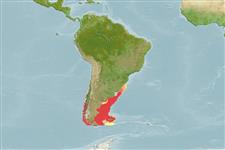Bivalvia |
Venerida |
Veneridae
Environment: milieu / climate zone / djupintervall / distribution range
Ekologi
; djupintervall 2 - 250 m (Ref. 87801). Temperate, preferred 12°C (Ref. 107945); 30°S - 55°S, 76°W - 50°W
Southeast Pacific and Southwest Atlantic: from Valparaiso to Magallanes, Rio Grande do Sul, Brazil then south to Falkland Islands.
Length at first maturity / Size / Weight / Age
Könsmognad: Lm ? range ? - ? cm Max length : 2.8 cm SHH hane/ej könsbestämd; (Ref. 81902)
Maximum length is based on data from Chile (Ref. 81902). Maximum depth from Ref. 111854. It is an infaunal species found on sandy, muddy, gravel and shell covered substrates at depths of 2 to 80 meters. Gonochoric species with free-living larvae (Ref. 87801). It is found in forests of Macrocystis pyrifera (Ref. 92889).
Life cycle and mating behavior
Könsmognad | Reproduktion | Lek | Eggs | Fecundity | Larvae
Members of the class Bivalvia are mostly gonochoric, some are protandric hermaphrodites. Life cycle: Embryos develop into free-swimming trocophore larvae, succeeded by the bivalve veliger, resembling a miniature clam.
SAUP Database 2006 SAUP Database. www.seaaroundus.org. (Ref. 356)
IUCN Red List Status
(Ref. 130435: Version 2025-1)
CITES status (Ref. 108899)
Not Evaluated
Not Evaluated
Threat to humans
Human uses
Fiskeri: kommersiell
FAO - fiskeri: landings | FishSource | Sea Around Us
Verktyg
Ytterligare information
Trophic EcologyFood items (preys)
Födosammansättning
Födointag
Predatorer
PhysiologySyreförbrukning
Human RelatedStamps, coins, misc.
Internet-källor
Estimates based on models
Resiliens
Mellan, lägsta populationsfördubblingstid 1,4-4,4 år (K=0.29).
Fishing Vulnerability
Moderate vulnerability (39 of 100).
Climate Vulnerability
Very high vulnerability (84 of 100).
Nutrients : Calcium = 149 [71, 228] mg/100g; Iron = 8.53 [1.95, 15.11] mg/100g; Protein = 9.88 [8.64, 11.12] %; Omega3 = 0.313 [0.202, 0.423] g/100g; Selenium = 61 [50, 72] μg/100g; VitaminA = 0 μg/100g; Zinc = 2.04 [0.56, 3.51] mg/100g (wet weight); based on
nutrient studies.
